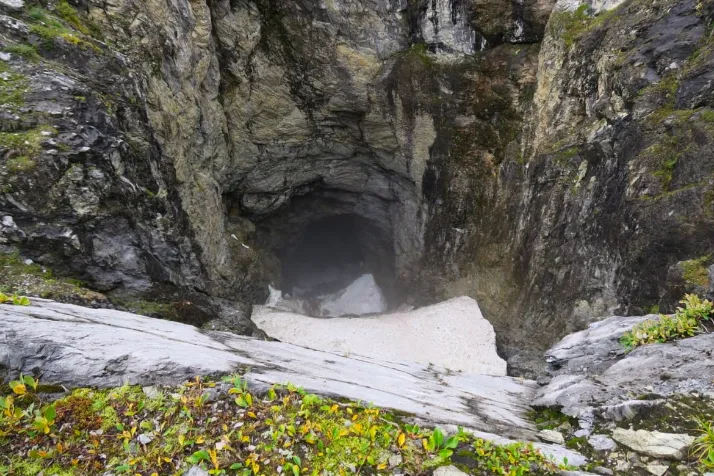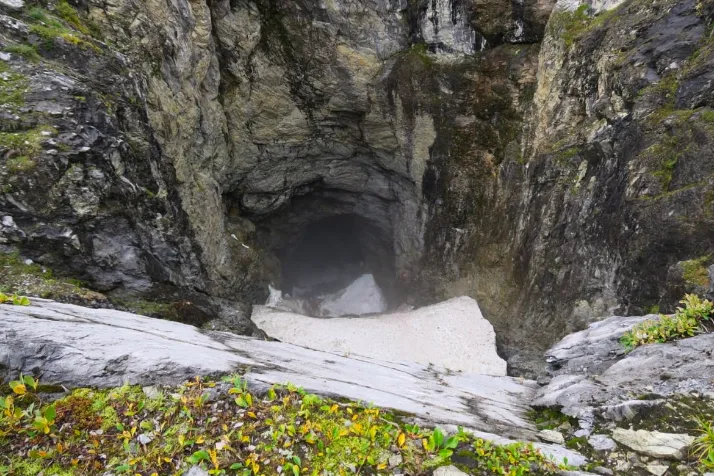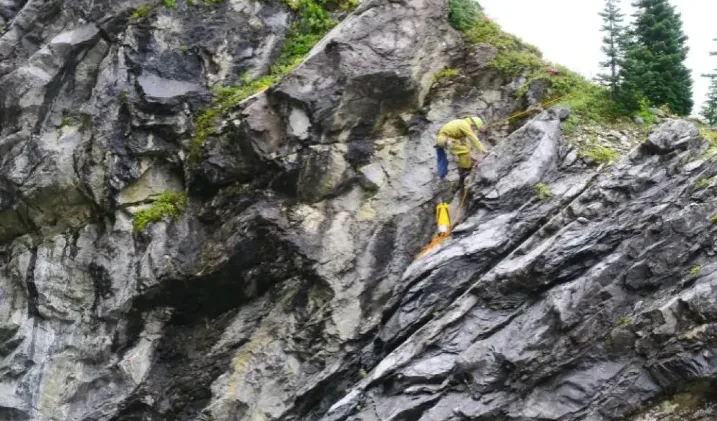
Massive, ancient cave in Canada went undetected for hundreds of years
This enormous, ancient cave in B.C.'s rugged alpine went undetected for hundreds of years largely because it was filled with ice and blanketed by snow until sometime within the last decade, researchers have found.
A scientific paper published this week said a steadily warming climate ate away at the snow plug until it suddenly collapsed, revealing the black hole in Wells Gray Provincial Park that was discovered in 2018.
"This is an amazing, amazing, earth-formed natural feature ... but, yes, [found] as a result of climate change, which is unfortunate," said geologist Catherine Hickson, who co-authored the paper after becoming one of the first people inside the cave entrance.
SEE ALSO: Ancient lost continent has been discovered in Northern Canada
Hickson and other geologists say the hidden cave's exposure is further proof of the power of climate change in reshaping the planet, but they admit the melt has opened up a tantalizing opportunity to explore what might be the largest cave entrance of its kind in Canada — a rare opening that could lead to a network of smaller caves and resilient life underground.
ICE 'LIKE A STOPPER IN YOUR SINK'
The opening of the cave, called a swallet, is a dip within a far-flung valley in B.C.'s Cariboo Mountains. Hickson said the cave acts like a drain for the glacier, swallowing a gushing river created by glacial runoff. The mouth of the cave is unique in the fact that it is a dramatic 145-metre vertical drop into the earth — a pit large enough to fit the Statue of Liberty.

The entrance to the cave. Geologist Catherine Hickson said the vertical height of the cave entrance is 145 metres, large enough to swallow the Statue of Liberty. (Catherine Hickson/Tuya Terra Geo Corp.)
Hickson said the cave is likely hundreds of thousands of years old. The area around the opening was covered by the perennial snowfield for centuries, the paper found, and was likely exposed in the late 1800s as the glacier slowly withdrew after the peak of the last ice age.
"Because it's cold [and] there's a significant amount of snowfall in that area, the ice core — like a stopper in your sink — was still present," Hickson said.
The cave was so hidden, one of Hickson's eventual co-authors didn't realize it was there when he camped a stone's throw away during a mapping expedition in the early 1980s.
"At the campsite, we saw the creek disappear at the cave site and marked its location," said Bert Struik, a scientific researcher with the Geological Survey of Canada. "We did not make a big deal of it at the time.
All you could see was "kind of a dip in a big snowbank and the water going in," Hickson explained.
Hickson and other researchers used Struik's notes from that trip, as well as photos taken of the cave site between 1949 and 2018, to determine the ice plug gave way sometime within the past 10 years.
"This collapse is likely related to climate change as evidenced by the gradual recession of glaciers in the immediate area," read the paper, published online in the Canadian Journal of Earth Sciences.
Brent Ward, a glacial geologist at Simon Fraser University, agreed the massive chunk of ice likely would have stayed in place if not for climate change.
"The amount of snow and ice that was in there, it's hard to melt that much material, especially at a high elevation such as this," said Ward, who did not participate in the research for the paper.
"Even if the glacier had retreated that far without anthropogenic [human-caused] climate change ... that snow bank and ice would not have melted without the warmer temperatures we're seeing in the summer."
Hickson said the sudden nature of the collapse is unsettling.
"I've been very aware of the ebb and flow of great glaciers over millions of years.... We're in an interglacial period. We know that these things happen," said Hickson, who completed her PhD research in the same park.
"It's the rapidity, how rapidly things are happening that is very disconcerting."

One of the researchers working with Catherine Hickson is pictured climbing into the cave entrance during an expedition in September 2018. (Catherine Hickson)
Hickson said the sudden nature of the collapse is unsettling.
"I've been very aware of the ebb and flow of great glaciers over millions of years.... We're in an interglacial period. We know that these things happen," said Hickson, who completed her PhD research in the same park.
"It's the rapidity, how rapidly things are happening that is very disconcerting."
'GIGANTIC HOLE' FINALLY SPOTTED IN 2018
The cave was spotted after a group of government researchers and biologists flew over the area for a mountain caribou census in the spring of 2018.
"Of course they saw this gigantic hole," said Hickson, who got a call from the helicopter pilot.
The cave will not officially be named without consultation with Indigenous communities. It was initially dubbed "Sarlacc's Pit" due to its resemblance to a mythical creature in Star Wars: Return of the Jedi, but the name is no longer used.
Its precise location is kept secret to deter amateur climbers and Instagram tourists from damaging the environment. Trespassers face a fine of up to $1 million.
Hickson and her colleagues obtained a permit to explore the mouth of the cave to assess its size in 2018. They spent 10 hours gathering what information they could, surrounded by the roar of the gushing river and the smell of cold, damp stone.
The cave is a variety of "striped karst," made up of marble melded with other types of ancient ocean rock to create a striped surface.
The team has applied for a multi-year research permit with BC Parks to begin exploring further in the fall of 2021. There is a narrow window for exploration, as it's only safe to enter the cave when the river levels are low in September and October.
Hickson has a prediction about what might be found inside.
"We think it may connect to a much more ancient cave system," Hickson said.
"What we don't know is the state of those open passages, how far they go," she said. "We know that in other caves around the world, there's life that has been adapted to that extreme environment. But until we actually go down there, we're not going to be able to say very much."
This article was originally published by CBC News and written by Rhianna Schmunk.
